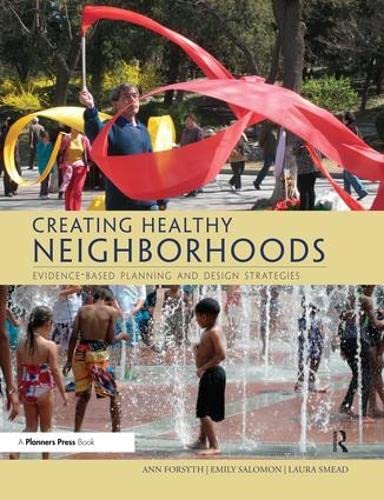All books / Book
Creating Healthy Neighborhoods: Evidence-Based Planning and Design Strategies

| Full title: | Creating Healthy Neighborhoods: Evidence-Based Planning and Design Strategies |
|---|---|
| ISBN: | 9781611901917 |
| ISBN 10: | 161190191X |
| Authors: | Smead, Laura Salomon, Emily Forsyth, Ann |
| Publisher: | Routledge |
| Edition: | 1 |
| Num. pages: | 264 |
| Binding: | Paperback |
| Language: | en |
| Published on: | 2017 |
Read the reviews and/or buy it on Amazon.com
Synopsis
Introduction : Toward Healthy Neighborhoods -- Principle 1. Importance : Assess How Health Matters In This Place. Proposition 1 : Figure Out If There Are Good Reasons For Considering Health ; Proposition 2 : Identify An Initial List Of Neighborhood-relevant Health Issues ; Proposition 3 : Figure Out If Anyone Else Cares -- Principle 2. Balance : Make Healthier Places By Balancing Physical Changes With Other Interventions To Appeal To Different Kinds Of People. Proposition 4 : Understand That Trade-offs Are Inherent In Planning For Health At All Scales And This Is True Of Neighborhoods As Well ; Proposition 5 : Appreciate That There Is No Ideal Size For A Healthy Community, But Different Dimensions Of Health Relate To Different Scales --^ Principle 3. Vulnerability : Plan And Design For Those With The Most Health Vulnerabilities And Fewest Resources For Making Healthy Choices. Proposition 6 : Create A Variety Of Housing Options To Promote Housing Choices Within The Neighborhood ; Proposition 7 : Integrate Universal Design Principles Into Neighborhood Planning And Design ; Proposition 8 : Increase Choice, Access, And Exposure To High Quality, Diverse, And Healthy Food Options, Especially In Low-income Areas -- Principle 4. Layout : Foster Multiple Dimensions Of Health Through Overall Neighborhood Layout. Proposition 9 : Create Mixed Use Neighborhoods With A Balance Of Activities That Support Good Health ; Proposition 10 : Provide Enough Density Of Population To Support Services For A Healthy Lifestyle ; Proposition 11 : Create A Connected, Healthier Travel Circulation Pattern For Pedestrians, Bicyclists, And Transit Users--^ The Vehicular Pattern Can Be Different ; Proposition 12 : Increase Access To A Variety Of Locally Relevant Recreational Facilities And Green Spaces -- Principle 5. Access : Provide Options For Getting Around And Increasing Geographic Access. Proposition 13 : Coordinate Land-use Planning And Urban Design With Transit To Increase Efficiency, Access, And Mobility ; Proposition 14 : Adopt Policies And Planning Practices To Create Safe Neighborhood Transportation Options For All Types Of Road Users ; Proposition 15 : Ensure Adequate Pedestrian And Cyclist Infrastructure And Amenities -- Principle 6. Connection : Create Opportunities For People To Interact With Each Other In Positive Ways. Proposition 16 : Create Publicly Accessible Neighborhood Spaces, Programs, And Events To Support Healthy Interactions And Behaviors ; Proposition 17 : Design The Public Realm To Reduce Street Crime And Fear Of Crime --^ Principle 7. Protection : Reduce Harmful Exposures At A Neighborhood Level Through A Combination Of Wider Policies And Regulations Along With Local Actions. Proposition 18 : Reduce Pollutants And Chemicals At The Source And Separate People From Toxins Through Buffers, Technology, Or Design ; Proposition 19 : Separate People And Infrastructure From Areas Vulnerable To Natural Disasters And Build In Resilience Through Technology Or Design ; Proposition 20 : Reduce Unwanted Local Noise Exposure At The Source, And Separate People From Noise Through Buffers, Technology, Or Design -- Principle 8. Implementation : Coordinate Diverse Actions Over Time - Conclusion -- Appendix A : Actions Checklist -- Appendix B : Health Topics Addressed By Section. Ann Forsyth, Emily Salomon, Laura Smead. Includes Bibliographical References (pages 212-241) And Index.